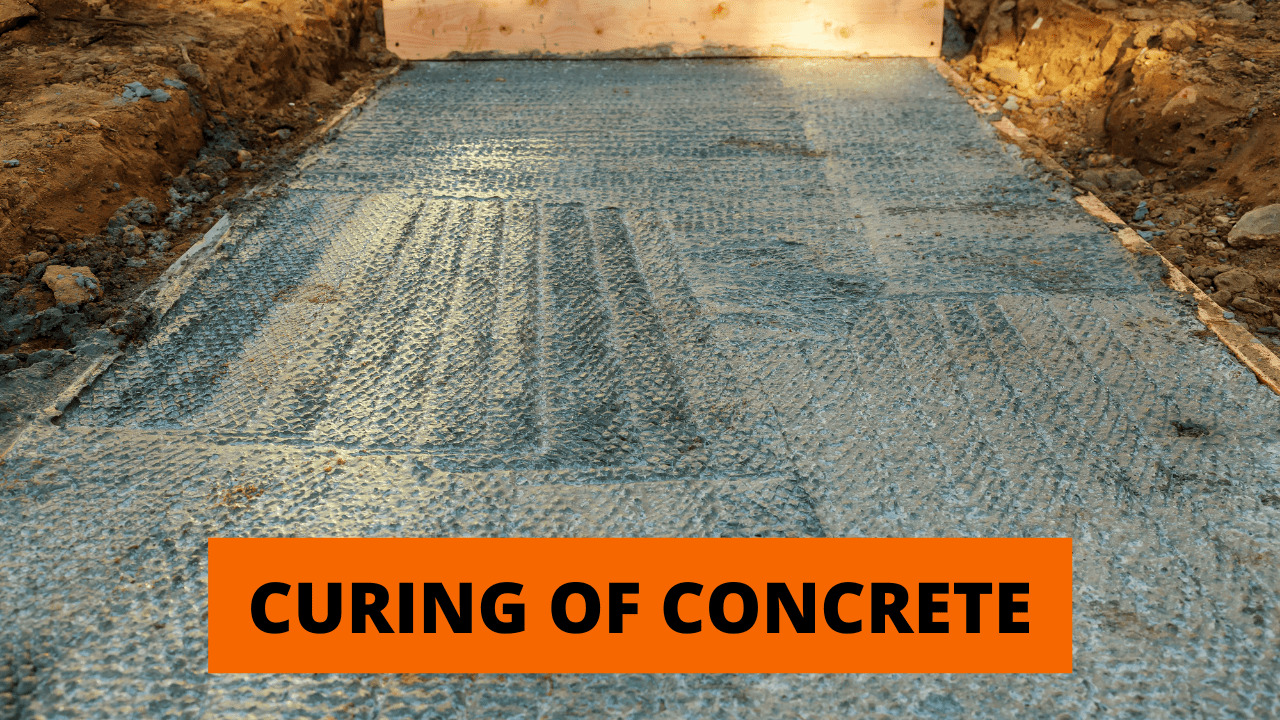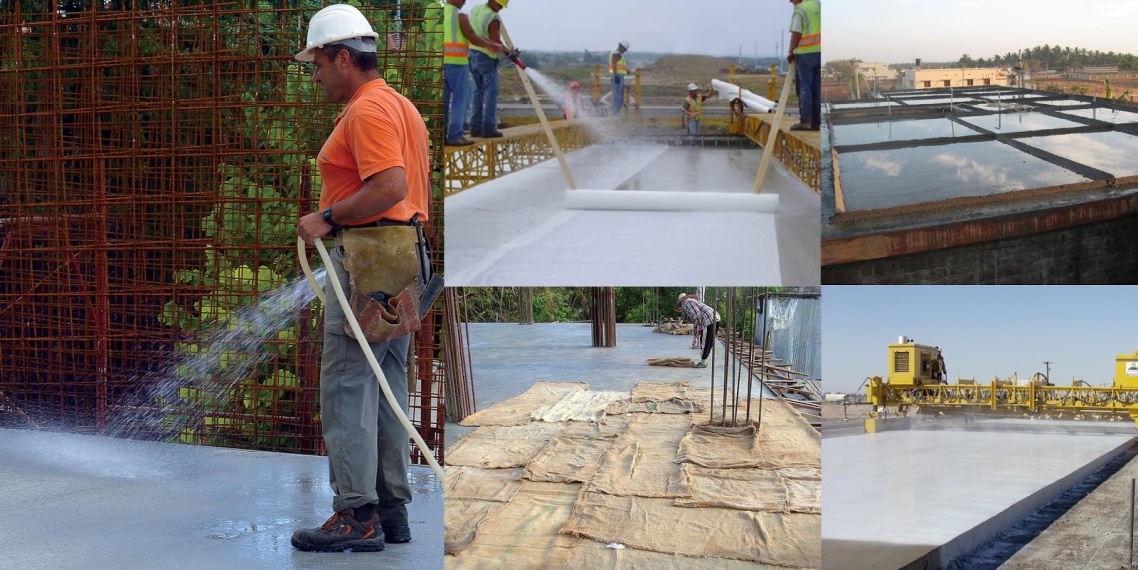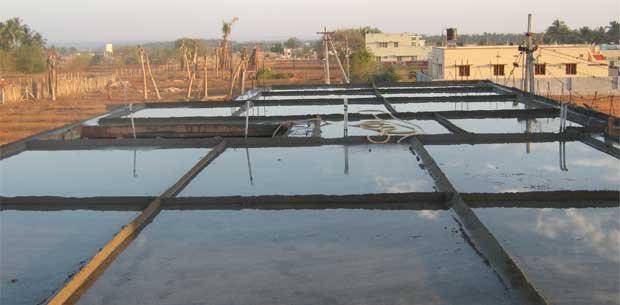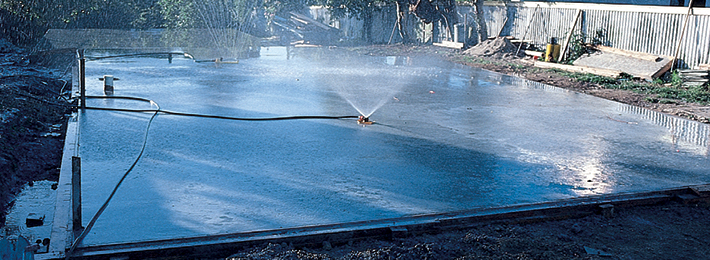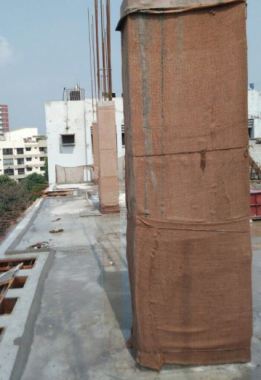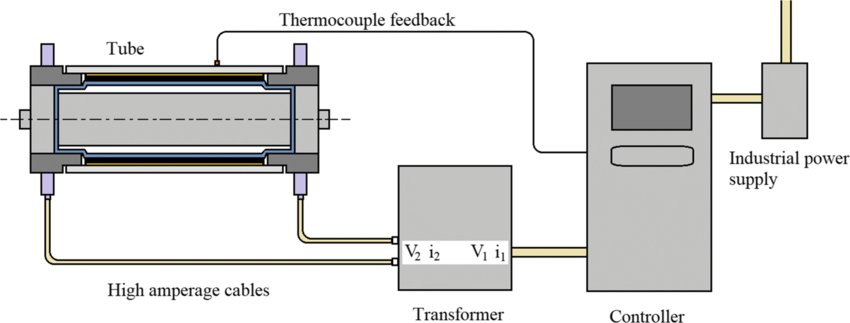In this article, we will learn about different methods for curing concrete. To understand these methods, firstly, we should know why curing is necessary for concrete during construction. The composition of concrete includes cement, sand, and aggregates. It is one of the most common construction materials used in the construction industry.
Following are the main components of concrete.
- Cementitious Material (Cement or lime)
- Coarse Aggregate
- Fine Aggregate
- Water
When the concrete is fresh, it can mold in any shape due to its plasticity. Many chemical reactions occur in the concrete that causes dehydration of concrete. This dehydration can lead to many problems in concrete. That is why concrete should be placed properly before its hardening. The time required for its hardening is the final setting time of concrete.
Table of Contents
What is Curing?
It is a process that helps in the hydration of concrete after placing and maintaining its temperature within a range. Curing will preserve the moisture loss in concrete and will increase the stability of the concrete.
When the concrete starts to dry and also gains its strength, it should be moist enough. To lock this moisture, the curing of concrete is essential during the hydration process of concrete.
Importance of Curing Concrete
There are some advantages of concrete curing.
- It will prevent concrete from thermal cracking.
- It elevates the durability of concrete.
- It will increase the moisture content in concrete up to a satisfactory level.
- It also prevents shrinkage cracks.
- It enables the concrete for abrasion resistance.
- It will enhance the stability of concrete.
- It will cause a reduction in permeability.
- It provides the excellent performance of concrete.
- It provides quality control in the concrete.
- The concrete with proper curing also protect the steel from corrosion.
Groups of Curing of Concrete
There are two main groups for the curing methods of concrete.
- This first group involves methods that have a direct connection with the surface of the concrete.
- This second group includes the processes that preserve concrete from its moisture loss by covering concrete.
- The third group includes a sprinkling process on concrete.
Curing time for concrete
The time required for the curing of concrete has a direct relation to its stability. These are some time ranges for the drying of concrete.
- After 24-48 hours (After this time, the concrete surface is liable for walking purposes)
- 7 days (Concrete surface gains its maximum strength at the stage of partial curing)
- 28 days (concrete with complete curing)
Methods of Curing
There are many factors upon which the curing of concrete is dependable. These are the following factors.
- Site location
- Accessibility of curing materials
- Type of the structure
- Weather conditions
By considering these factors, there are different types of methods for the curing of concrete.
1)Water Curing
This method involves the direct application of water on the concrete surface to control the hydration process of concrete. It is a convenient method for curing. This method is suitable for the curing of slabs and pavements.
This method also includes some different types for curing.
- Ponding method
- Sprinkling method
- Wet coverings
- Left in place forms
Now, we will discuss all these methods with their details.
a)Ponding method
This method involves the curing process in the form of a pond. The concrete surface filled with water like a pond and left for a definite time. It is an effective method for flat areas and pavements. It can also save moisture loss from concrete easily.
b)Sprinkling method
This method involves the sprinkling of water on the concrete surface through a medium. It is also a significant way of curing concrete.
- It provides a uniform amount of water
- This method helps to maintain the temperature
- It helps to control the humidity level
This type of curing is also done by installing sprinklers in an adequate space.
c)Wet coverings
This method involves the placing of wet mats, rugs so that they help to resist the moisture of concrete. This method is efficient for such places where there is a shortage of water availability.
- This method is suitable for columns, the bottom of slabs where ponding is inaccessible.
- After the placing of these coverings, they get saturated after some time.
- This method should start before the hardening of concrete.
- Gunny bags and hessian are examples of wet coverings.
d)Formwork In Place Curing
This method involves the placing of formwork a bit longer than usual for curing purposes. It also provides sufficient moisture control for the curing of concrete.
- This method accelerates the process of curing.
- It helps the uncovered area for better curing.
- It is helpful for hot and dry weather.
- It preserves the temperature released from the concrete.
2)Membrane Curing
This method involves the formation of a membrane over the concrete surface that helps to resist the moisture of concrete. This membrane can be in the form of a solid or a liquid by brushing or spraying the curing materials. This method is suitable where sufficient water is not present.
- It is an instant method of curing.
- It does not need any inspection.
- The results are much lesser than the moist curing.
- Bitumen emulsions, resins, plastic films are used to form a membrane.
3)Sheet Curing
This type of curing involves the placement of different sheets for the curing of concrete surfaces. Plastic sheets, polythene sheets, or curing blankets can be significant for such methods.
- It is also suitable for flat surfaces like slabs.
- These sheets are lightweight and easy to handle.
- Curing blankets also protect against the evaporation of moisture from the concrete.
- It is also an easy and effective method.
4)Steam Curing
In this method, steam is provided for the curing of concrete for its higher strength.
- It is suitable for pre-cast concrete curing.
- It fastens the process of curing.
- Temperature can be adjustable to deal with humidity.
- It reduces the time for gaining the strength of concrete.
5)Electrical Curing
This method involves the passing of electric current through the concrete surface. It consists of two electrodes on the two opposite sides of the concrete surface that helps to generate an electric current. It will help to produce heat for the concrete surfaces.
6)Infrared Curing
This method involves the infra-red rays passing through the concrete surface.
- It is an effective method to increase the strength of concrete.
- These rays help to increase the initial temperature of concrete up to 900.

